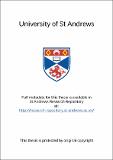Files in this item
A study of the dissipation which accompanies superfluid flow in liquid helium films
Item metadata
| dc.contributor.advisor | Allen, J. F. | en |
| dc.contributor.author | Saunders, Brian Leonard | en |
| dc.coverage.spatial | 194 p | en |
| dc.date.accessioned | 2021-04-08T08:59:30Z | |
| dc.date.available | 2021-04-08T08:59:30Z | |
| dc.date.issued | 1974 | |
| dc.identifier.uri | https://hdl.handle.net/10023/21936 | |
| dc.description.abstract | The damping of the inertial oscillations of a flowing helium film was found to be well accounted for by a theory put forward by Robinson. In particular this theory predicts that the damping constant should reach a maximum value at a temperature below the lambda point and should decrease at higher temperatures. This behaviour was observed and the values of the damping constant were in good agreement with theory. The mechanism suggested by Robinson was that the energy of the flowing liquid could be lost in irreversible heat exchange between the beaker and the reservoir causing the decay of the oscillations. It has been shown that, in the case considered here, the heat exchange was dominated by distillation and that this process was well described by the evaporation equation given by Atkins if due allowance was made for the shape of the helium surface. Earlier attempts by other workers have not found good agreement with Robinson, nor has the maximum in the damping been previously observed. (Hoffer et al have reported the observation of the maximum in experiments carried out independently, at the same time as the work reported here.) The improvement in agreement may have been brought about by the elimination of vibration by the extensive anti-vibration precautions included in the design of the cryostat. The dissipation accompanying the flow of superfluid at velocities driven by level differences greater than about 30um, that is at velocities greater than those encountered during the inertial oscillations, was measured and compared with two models based on the production of vorticity from thermal fluctuations. The form of the dependence of the flow rate on level difference was found to be similar to that predicted by each of the models but numerical agreement with the characteristic parameters of the theories was poor. In particular the attempt frequency was found to exhibit a dramatic temperature dependence, changing by ten orders of magnitude for a change of the temperature of about 0.5 K! It was shown that mutual annihilation of vorticity could account for this large variation. If the flow rate is interpreted in terms of these models, then the flow is found to be never strictly frictionless and therefore, a true "critical velocity" was not observed. | en |
| dc.language.iso | en | en |
| dc.publisher | University of St Andrews | en |
| dc.subject.lcc | QC278.S2 | |
| dc.subject.lcsh | Liquid helium | en |
| dc.subject.lcsh | Superfluidity | en |
| dc.title | A study of the dissipation which accompanies superfluid flow in liquid helium films | en |
| dc.type | Thesis | en |
| dc.type.qualificationlevel | Doctoral | en |
| dc.type.qualificationname | PhD Doctor of Philosopy | en |
| dc.publisher.institution | The University of St Andrews | en |
This item appears in the following Collection(s)
Items in the St Andrews Research Repository are protected by copyright, with all rights reserved, unless otherwise indicated.

